LAS VEGAS — This writer has clocked out after five days at Summer League. But first, some observations. Most of this year’s rookie class took the court in Las Vegas and left initial impressions with the entire league watching. Here’s what I noticed from the first sets of games.
1. Get ready to spend at least a few years comparing the trio of Paolo Banchero, Chet Holmgren and Jabari Smith Jr.
Banchero, Holmgren and Smith were drafted in that order, but debated every which way in NBA war rooms all season. All three had moments of brilliance in Las Vegas, as well as some occasional struggles—none of which were surprising if you’d followed these players closely going into the draft. And while I personally felt most strongly about Smith as the top prospect, there’s a universe where all three evolve into All-Star-level players and the Magic, Thunder and Rockets all walk away quite content with how things shook out.
It’s not often that the first three picks in a draft class play the same position—broadly speaking, they’re power forwards—but also possess vastly different skill sets, which sometimes makes this discussion feel more like a matter of aesthetic taste. How you separate Banchero, Holmgren and Smith from one another can be more reflective of what you value in a prospect than any stark gap in quality. And seeing them take the court against one another—Smith faced off against both, while Banchero sat out the Magic’s game against the Thunder—offered observers some additional food for thought.
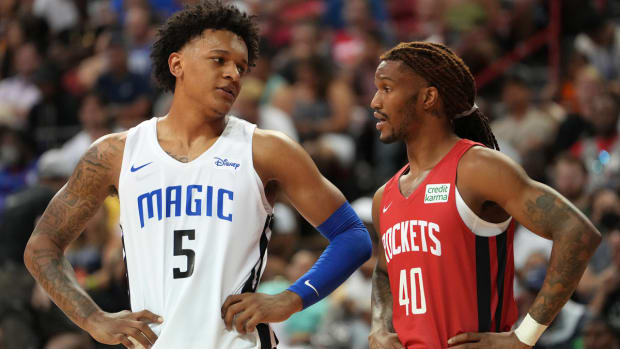
Stephen R. Sylvanie/USA TODAY Sports
Banchero played just two games in Vegas, totaling 40 points, 12 rebounds, 10 assists and 20 free throw attempts. He also turned the ball over 10 times, including eight in 25 minutes against Sacramento. The raw production is already there for him, but there’s clearly going to be an adjustment period as he learns what he can and can’t get away with. The Magic are going to let him play all over the floor and give him leeway to make mistakes early. Orlando’s need for an offensive focal point was likely a separator in its decision to pick him over Smith and Holmgren; Banchero has the most functionally guard-like skill set of the three right now. His ability to handle and pass with imagination makes him an exciting watch, but he’s still working to combine those skills toward a more consistent end product.
Because Banchero isn’t insanely explosive or fast, his dribble moves don’t yet lead to as many easy shot attempts as one might like. He prefers to initiate contact when playing downhill, but defenders can presently sag back and make him punish them with jumpers. He sometimes falls in love with making the difficult pass in lieu of making the simpler play. He’s got good creative instincts, but these are things he’ll have to keep sharpening as the competition gets tougher and more physical. But there’s a chance he can actually spend time playing on the ball. His ability to play both as a handler and screener in pick-and-roll situations makes him a unique schematic weapon from the get-go.
On the positive side, his jumper seems to be on a better trajectory right now than it was at times at Duke. He looked confident getting to it, although he still settles for a lot of tough shots. Banchero is also a lot more competent defensively than he got credit for, as his sheer size and smarts allow him to be disruptive and opportunistic when he wants to be. His effort defensively in Vegas was generally good, but the Magic will surely push him to take more pride in that part of his game. It’s easy to understand why Orlando took him first, particularly considering the state of its roster. Still, I don’t think he’s so far ahead of his peers that this will be one of those years where the top pick runs away as the clear top rookie.
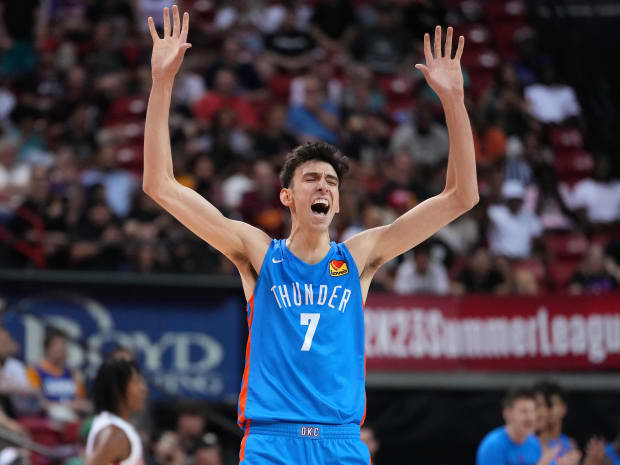
Stephen R. Sylvanie/USA TODAY Sports
2. The hype around Holmgren is here to stay.
Holmgren had his best Vegas game against Orlando on Monday while Banchero sat, depriving us of a rematch from November’s Duke-Gonzaga contest. For better or worse, Holmgren drives conversation and draws eyeballs, so get ready for a smattering of bad narratives and weird expectations surrounding his career. But the major things we knew to be true about Holmgren’s game were all pretty evident this week.
He’s an exceptional shot blocker, particularly when roving in space. When drivers don’t see him coming, they’re often toast. The Thunder seem to know this and are already giving him defensive assignments that allow him to spend more time operating like a giant free safety as the help defender. That part of his game should translate in a big way. Holmgren is also quite hard for opponents to score over when his feet are planted, with a great grasp of vertical defense and disruptive length. In those situations, Holmgren’s lack of strength is mitigated by his smarts, as he’s already pretty deft at avoiding unnecessary contact. When drivers are able to attack Holmgren’s chest and make him move his feet and backpedal, they’ve had some success, but at this point in his career, that’s mostly been easier said than done.
My personal concerns have more to do with Holmgren’s balance than any lack of strength, although I suppose the two are somewhat inextricable from one another. When he establishes good position or has an unfettered head of steam in pursuit, Holmgren fares just fine. But he frequently falls down and gets dislodged in the run of play, which limits his ability to physically impact the chaos that comes with operating on the interior. He’s already getting hit quite a bit. Holmgren will never be a hulking figure, but whatever core strength he can pack on without losing his mobility might go a long way for his outlook.
I’m still not particularly confident that Holmgren’s off-dribble game translates in an effective manner. It’s nice that he can bring the ball up the floor, but he frequently struggled to actually get by people and create advantages. There were a few glaring sequences against the Magic when Holmgren tried to operate off the bounce and 6-foot guard Zavier Simpson—a tough defender who spent last year in the G League—gave him serious problems. Holmgren’s high center of gravity and lack of bulk with which to shield the ball leaves his handle a bit susceptible. And if opponents can stick small guards on him in those situations, some of his mismatch value gets eliminated. He can still be quite valuable offensively—he has been shooting the ball really well in Summer League, has terrific feel for playing with teammates and is skilled enough to live on the perimeter—but the idea of Holmgren as jumbo guard still feels like a pipe dream to me.
The fascinating thing about Holmgren is that for all the weird cosmetic elements of his game, the results and raw production have tended to be there in the end at each stop. While there are going to be some hurdles for him—the physical challenge he faces certainly isn’t going to get any easier—Holmgren, to his credit, has always found ways to make it work. The reasonable question is whether the good things play up to the point where Holmgren can approach his ceiling as an All-Star and perennial All-Defense candidate, or if the limitations created by his unique build mean he levels out as more of a solid starter who helps drive winning. As long as he’s healthy, the floor should be pretty high here, and even his detractors have to acknowledge his early performances have left some room for optimism.
Watch NBA Summer League with fuboTV: Start a 7-day trial today!
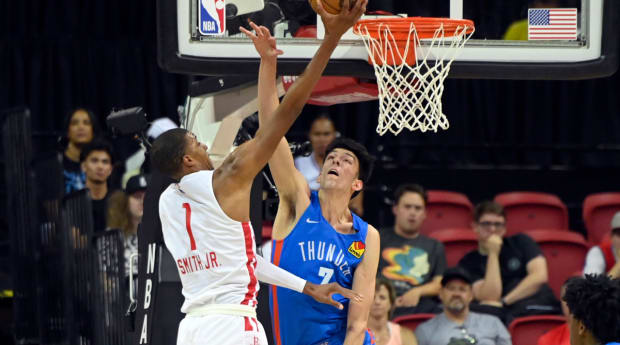
David Becker/AP
3. If there’s one player I’d caution not to worry about, it’s Jabari Smith Jr.
Smith didn’t shoot the ball well in his first couple of games for the Rockets, but looked more comfortable in his third one Monday. On the whole, he was pretty excellent in all other areas beyond making jumpers, which is not the thing to worry about with him. Yes, Smith often needs to be set up in his preferred spots by teammates right now, but I’d strongly caution not to conflate that with passivity or any lack of want. His ball security has to get much better, and he’ll need to learn to play off one and two dribbles a bit more decisively, but all the elements are there for him to make a massive leap as he adds muscle and gains confidence. Remember how early he still is in his development and how mature his approach is in other facets—he is unselfish, makes the right pass, communicates and competes at all times. There’s quite a bit to be excited about. Smith’s jump shooting is his best skill, and the shots will start to fall in time.
It’s an understatement that I spent a lot of time writing about Smith going into the draft. But I’m realizing after watching his first three games here that I may not have appropriately praised his defense: He was certainly on the short list of most impactful defensive players in Vegas, with a rare combination of balance, mindset and sheer size that make him extremely hard to score on in one-on-one situations. Smith was terrific defensively in individual matchups with Banchero and Holmgren, but he also showed the ability to consistently switch onto guards, chase down blocks in pursuit and battle physically against older, stronger players. He’s a special offensive prospect who also takes defense personally, which is not common.
Considering Smith is one of the youngest players in Vegas—and has pretty much always been young for his level—all this bodes extraordinarily well, shooting results aside. Smith was my top-ranked prospect for a reason, and I feel pretty confident that a big leap is coming, particularly as he packs on strength in his lower body, which will help him power to the basket and elevate for shots with a bit more consistency. It may take two or three years for that to fully bear fruit, and the Rockets are going to have to work to involve him, but this is still the guy I’d put my chips on. A megasized sharpshooter who is smart, tough and can switch everything on defense sounds pretty attractive, and that’s the baseline here. If and when his face-up game evolves to maximize the jumper, Smith is going to be scary good. Just be patient.
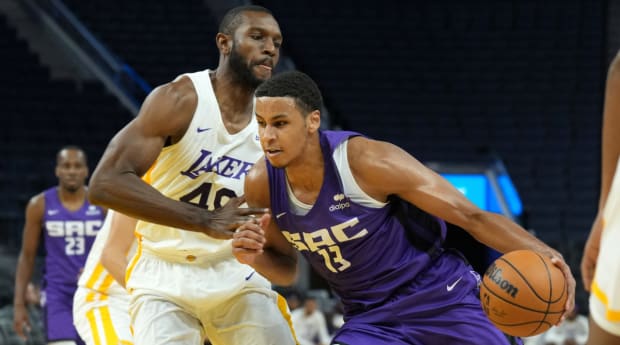
Darren Yamashita/USA TODAY Sports
4. Keegan Murray, Rookie of the Year front-runner?
I don’t know what type of ROY odds you can get on Murray right now, but based on all we’ve seen thus far, the Kings forward has to be among the early front-runners. It shouldn’t be a surprise that Murray—the most consistent of college basketball’s elite performers last season—was arguably the best rookie performer at Summer League. After a strong showing at the California Classic last week, Murray totaled 40 points in his first two games in Vegas, draining four threes in each game and playing active, smart basketball. Murray also hit a game-tying three in a scramble situation at the end of regulation in an epically exhausting game against the Magic on Saturday. He’s been as advertised.
The Kings drew some scrutiny in the public sphere for taking Murray and passing on Jaden Ivey at No. 4, but it was even more evident from watching Ivey here in Vegas that his massive talent is still going to take quite some time to harness. He’s an incredible athlete, but high-octane scoring guards who need the ball a lot often take quite a bit of time to iron out their shot selection and decision-making. I feel like I’ve written some version of this concept on several different occasions, but considering the state of Sacramento’s roster and the organization’s playoff ambitions, unless the Kings had absolute confidence that they’d be able to develop Ivey in an optimal manner, the value proposition of selecting him simply wasn’t as high for them as it was for the Pistons, who are in an earlier building stage and can fit him neatly into their plans in a mutually beneficial way.
This is all to say that I’m pretty certain Murray will stand as a strong pick for the Kings in the short and long run. His ability to cut, relocate, rebound and play with energy, and generate offense without being force-fed touches makes him a player who’s almost universally deployable in lineups regardless of context. While Murray is significantly older than Banchero, Holmgren and Smith (he turns 22 in April), it’s evident that he has quite a bit of room left to grow his game, on top of myriad things he already does well. His overall efficiency and low-maintenance game remain a bit of a marvel, and it’s the type of thing that doesn’t always get properly appreciated. Murray isn’t flashy, but he does some special things.
As far as upside is concerned, Murray already made some serious strides as a jump shooter and is growing comfortable launching threes on the move, a skill set that could drastically spike his value if fully realized. He has some occasional tentative moments as a shooter, but it’s clearly trending up. There’s also a lot of room for Murray to expand his play off the bounce, which is a bit limited in isolation situations, but not a huge deal considering how effective he is in other areas, and how well he knows his own limits. He’s going to be productive right away, he should be a neutral defender at worst, and he might pair particularly well on offense with Domantas Sabonis, with his cutting and shooting ability a natural match with Sabonis’s passing vision. Whether this gets Sacramento to the playoffs right away, I’m not sure. But I’m excited to see what adding Murray to the mix looks like, which is not something that’s been said much about the Kings in recent memory.
5. Indiana’s Bennedict Mathurin looks ready to score the ball at the NBA level.
Mathurin scored 23, 15 and 20 points in his first three games and looked a lot more confident as a pull-up shooter. Mathurin isn’t a flashy ballhandler, but he is explosive and has learned to get downhill effectively, forcing teams to account for him on drives as well as close out hard on his open jumpers. That’s the type of skill set that can make him plenty dangerous, and he’s probably going to be effective in some capacity right away.
I still have a few key concerns with Mathurin, whom the Pacers drafted at No. 6: He isn’t a creative or consistent passer, isn’t always an engaged defender yet and isn’t great when forced to improvise. He’s become a lot more decisive and confident in the things he does well, which mitigates some of the issues on offense—nobody expected him to be a point guard or anything. Mathurin’s athletic play-finishing should be an outstanding fit with Tyrese Haliburton, and I’m curious to see them play in tandem. He is more like 6'5" than his listed 6'6", and isn’t a hulking wing scorer, but he has made some good improvements to his game and is still just 20 years old. He also looked more comfortable at Summer League than Washington’s Johnny Davis, a player against whom he was often debated in front offices.
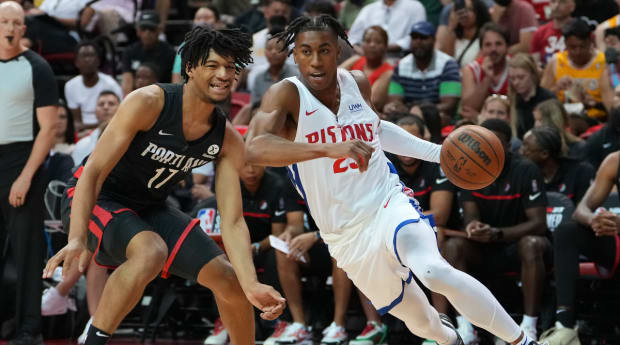
Stephen R. Sylvanie/USA TODAY Sports
6. We only got brief glimpses of some of the draft’s most exciting prospects due to unfortunate injuries.
Jaden Ivey fared pretty well in his debut, scoring 20 points with six assists (in spite of five turnovers) and leading the Pistons to a win. He injured his ankle early in the Pistons’ game Saturday and was subsequently shut down. Portland’s Shaedon Sharpe injured his left shoulder just a few minutes into his first Summer League game, postponing our first real look at him. Dyson Daniels hurt his ankle early in New Orleans’s first game, which also ended his Summer League stint. Spurs forward Jeremy Sochan sat out Summer League completely after missing early practices due to a positive COVID-19 test, while also coming off a hamstring injury he suffered in a predraft workout.
These were all major bummers for eager observers, particularly Sharpe, whom the entire NBA was eager to check in on following his nonseason at Kentucky and selection at No. 7. The Blazers took a big gamble on him, particularly considering that his skill set was a bit duplicative with Anfernee Simons and that a safer, more versatile player in Daniels was on the board. In my conversations with team personnel, Portland’s Sharpe selection has remained one of the more scrutinized draft-night decisions around the league. He hit one smooth jumper in his four minutes of play, but there wasn’t much else to say of consequence. Any sort of early verdict will have to wait until the season, it seems.
7. This week wasn’t all about rookies.
Warriors center James Wiseman took the court Sunday in another step back toward a full return from tearing his meniscus in April 2021, playing in short bursts to some mixed results. He finished with 11 points in 19 minutes but grabbed just two rebounds. His minutes weren’t as good Tuesday, but simply getting back on the court was a good start.
At this point, whatever Golden State gets out of Wiseman moving forward is kind of a luxury: He’s only 21 years old and still theoretically in a great situation if he can simply earn the playing time. He remains a powerful athlete with outstanding height and reach at 7'1", and a viable shooting touch. The Warriors’ patented style of play, driven by ball movement, quick decisions and the brilliance of Steph Curry will simply ask Wiseman to set good screens, make himself a target to receive and finish plays, and knock down open shots. But earning minutes on a veteran team preparing a title defense will also require Wiseman to think faster on the court and polish up the finer points of his interior play. He still gets caught out of position a bit defensively and can be foul prone, and he needs to rebound in a manner befitting his size.
Wiseman has always had a tendency to float a bit, and it’s hard to expect a finished product anytime soon, considering the minimal amount of competitive basketball he’s played in his young career relative to his peers. He played three games in college, logged 39 appearances as a rookie before his injury and had a brief two-game stint in the G League toward the end of last season. He didn’t play at all during the Warriors’ playoff run. The matter of being available has been a challenge, and only some of that has been within Wiseman’s control, but as he approaches a potential contract extension in 2024, simply being on the court the next two seasons might go a long way.
After winning the title, Golden State retains the luxury of being able to incubate blue-chip talent while continuing to contend over the next few years: Wiseman, Jonathan Kuminga and Moses Moody all participated in Summer League and figure to be called upon for depth next season. Patrick Baldwin Jr., the 28th pick, has been sitting out this week, as the Warriors are taking the long view with him and allowing him to fully rehab the injured ankle that’s plagued him for the past couple of years. And Summer League invitee Mac McClung has been one of the better guards in Vegas, turning himself into a potential roster candidate for Golden State. All four recent first-rounders were elite recruits in high school and could be essential parts of a post-Curry future. One key subtext for the Warriors next season will be how their careers continue to take shape.
8. Two other highly drafted rookies who deserve some mention.
Oklahoma City’s Jalen Williams and Houston’s Tari Eason both stood out more often than not and figure to play big minutes on their respective rebuilding teams next season.
Williams’s ascent from projected second-rounder to 12th pick was one of the better stories of the predraft process. He was one of a handful of top prospects I never saw live before the draft, and the NBA on the whole was a bit slow on the uptick, but he proved himself in workouts, stood out at the combine and played his way into the lottery. He’s looked the part for the Thunder right away, moving the ball well and playing steady defense and looking like a stronger candidate for bench minutes than fellow rookie Ousmane Dieng. The pass-dribble-shoot skill set coupled with his length and poise are a strong combination.
I’ve always been a bit cautious evaluating Eason, as his approach to the game can be a bit reckless and his situational awareness is sometimes lacking. That said, he was more often than not pretty good in Vegas—he plays hard, he’s an elite run-jump athlete and it’s easier to live with the occasional wild pass and stray jump shot when he’s producing. I’d like to see him commit a bit more to playing team basketball and involving teammates, but regardless, it’s clear he’s going to have a shot to carve out a niche. Houston made out pretty well with its trio of first-rounders, with Eason, Smith and TyTy Washington Jr. all making good contributions.
9. Denver’s Peyton Watson and Orlando’s Caleb Houstan look like steals.
While it’s important not to react too strongly either way to what we see in Summer League, Watson and Houston are two rookies who fell in the draft who I’m pretty sure I didn’t rank highly enough on the Big Board. It’s not a coincidence both were one-and-done college freshmen who underwhelmed in their respective situations, making for difficult evals based on the information and film at hand. That absence of certainty was also reflected in their draft position: Watson was selected 30th and Houstan 32nd. Both look like potential value picks after their respective stocks took a hit during the season.
After a tough season at UCLA led to sporadic minutes and inconsistent playing time, it was nice to see Watson—once a projected lottery pick—get a chance to build some confidence this week. He was particularly good Sunday, scoring 19 points on 8-of-12 shooting to go with seven rebounds, two steals and a block. He’s always been an excellent defensive prospect, as a legitimate 6'8" forward with a 7' wingspan who has quick enough feet to guard all over the perimeter. While Watson has a ways to go as a shooter and is still playing catchup in terms of logging high-level minutes, he’s looked much closer to contributing than was expected after averaging just 3.3 points per game in 12.7 minutes in college. There are going to be some bumps in the road, but as long as Watson continues to play with energy, the defensive cover he offers might expedite his pathway to an NBA role.
Houstan was pretty solid for the Magic in Vegas, particularly on opening night against the Rockets, when he scored 20 points on 12 shots and hit 5-of-9 three-point attempts. Another player who once received lottery-level hype, Houstan didn’t fully adjust to the physicality of the Big Ten and was also hurt by Michigan’s lack of quality guard play, but he still shot 35% from three on 166 attempts. He needs to get tougher on the defensive end, but Houstan has always been a smart team player, relocates well as a shooter and knows how to play a supporting role. He also has an exceptionally quick, clean release and doesn’t dip the ball unnecessarily on his shot. Houstan looks to have added some muscle, and his size at 6'8" should play up in spite of average athleticism. He was a tougher sell in the first round after an underwhelming season, but it’s pretty easy to see how he becomes a useful rotation player in time.
If there’s a takeaway here, it’s that buying low on these types of prospects, particularly those with size, tools and an obvious pathway into developing at least one elite skill (Watson’s defensive versatility and Houstan’s shooting), tends to be good business in the middle of the draft. And while more experienced, proven players got a bit of a bump this year in the 19–26 range of the draft, the talent gap wasn’t ever particularly wide. It’s always nice to see these types of reclamation projects work out, and I feel much better about both players than I did a month ago.
10. A parting note about Summer League basketball.
It’s fun to nitpick rookies, think about the draft and form early opinions, but a lot of that winds up being useless, frankly. From a serious player evaluation standpoint, often it’s more productive to ask the question of which veteran players are still playing in Summer League and why they haven’t yet graduated. (Many never will.) Those patterns are often useful when looking at prospects and trying to project out: For example, there are a wealth of small guards and lumbering centers here. Suffice it to say that those guys tend to be in high supply and minimal demand when it comes to filling out NBA rosters. The macro trends and ideas buried in the context of these games often matter more than who shot well or who won.







